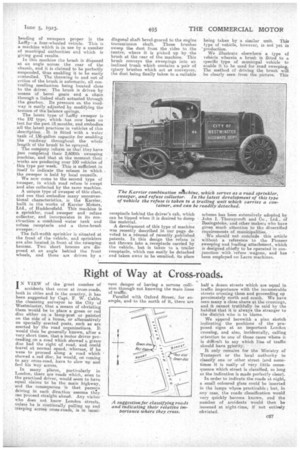Right of Way at Cross-roads.
Page 11

If you've noticed an error in this article please click here to report it so we can fix it.
I N VIEW of the great number of accidents that occur at cross-roads, both in cities and in the country, it has been suggested by Capt. F. W. Cable, the cleansing surveyor to the City of Westminster, that a means of obviating them 'would be to place a green or red disc either on -a lamp-post or painted on the side of a house, or alternatively on specially erected posts, such as are erected by the road organizations. It would then be generally known, after a. very short time, that a motor driver proceeding on a road which allowed a greendisc had the right of road-, and could travel at normal speed, whereas, if he were to proceed along a road which showed a red disc, he would, on coming to any cross-road, have to slow up and feel his way across.
In many places, particularly in London; there are roads which, even to the practised driver, would seem to have equal claims to be the main highway, and the consequence is that persons driving in each direction assume they can proceed straight ahead. Any visitor who does. not know London streets, unless he is continually pulling up and
i
creeping across cross-roads, is n imrni
netd danger of having a serious collision through not knowing the main lines of traffic.
Parallel with Oxford Street, for• example, and to the north of it, there are half a dozen streets which are equal in traffic importance with the innumerable streets crossing them and proceeding ap proximately north and south. We have seen many a close shave at the crossings, and it cannot truthfully be said by the habitu6 that it is always the stranger to the district who is to blame.
We append herewith a plan sketch indicating the positions of the proposed signs at an important London crossing, and also, incidentally, calling attention to one of those cases where it is difficult to say which line of traffic should have priority.
It only remains for the Ministry of Transport or the local authority to classify one or other street (and sometimes it is really of very little consequence which street is classified, so long as the indication is made perfectly clear).
In order to indicate the roads at night, a small coloured glass could be inserted in the lamps where practicable ; but, in any case, the roads classification would very quickly become known, and the number of accidents would then be lessened at night-time, if not entirely obviated.








































